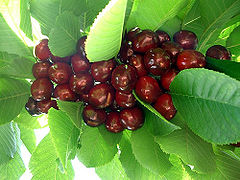Cherries
| Infobox on Cherries | |
|---|---|
| Example of Cherries |  |
| Freshness facts | |
| Optimum carrying temperature | -0,5°C/+0,5°C |
| Highest freezing point | -1,8°C |
| Acceptable product temp. at loading into containers | Max. 2°C above carrying temperature |
| Optimum humidity | 90 to 95% |
| Ventilation setting for containers | 0-10 m³/hr |
| Storage life | 3 weeks |
| Climacteric / non-climacteric | Non-climacteric |
| Ethylene production | Very Low |
| Ethylene sensitivity | Low |
| Modified / controlled atmosphere | 10%-15% CO2; 3%-10% O2 |
| Potential benefits | Moderate to high |
| Availability | |
| Australia/New Zealand South Africa South America Europe |
December - January October - December October - December May - September |
Cherries
Contents
Harvesting and handling
There are many cherry varieties, each one with very peculiar characteristics, large, small, red, orangy, sweet, acid, etc. Cherries are stone fruit (Prunus). Cherries appear to have a non-climacteric pattern of respiration and their texture and flavour do not alter significantly after harvest. All stone fruits are prone to serious postharvest decay, the most important diseases being blue mould rot, brown rot, grey mould rot and rhizopus rot. Infection and development of disease organisms is minimised by prompt cooling; if hydro-cooling is used, the water must be properly chlorinated (unless a fungicide or an antagonist be incorporated). With regard to disorders, stone fruits are subject to various types of injury and breakdown, influenced by cultivar, orchard and climatic factors, harvesting and handling practices and storage environment.
Premium sweet cherries have a bright, shiny appearance with fruit colour ranging from dark red (‘Bing’), red (‘Sweetheart’) or yellow with a red blush (‘Rainier’ and ‘Royal Ann’). The appearance of the stem, green and free from brown discolouration, is also critical for marketing. Flavour is enhanced by high soluble solids and titratable acid content with a firm, juicy fruit texture.
Cooling and storage
Cherries are regarded as a high value, sought after product. Sea shipments can be successful, but very strict temperature control must be exercised. The fruit is very soft, has a tender skin, ripens fairly fast and is therefore regarded as very sensitive to handling and transport. Fast cooling to -0,5ºC immediately after harvest and not allowing the pulp temperature to exceed 0ºC during handling and transport is the key to successful sea shipment. Cherries also do not have a long storage and shelf life and should therefore be handled without delay to ensure they are offered to the retail market within 21 days from picking.
However, modified atmosphere obtained with the use of polyethylene liners can prolong the market life of sweet cherries. These liners must be opened when the fruit is removed from cold storage to prevent development of off-flavours at higher temperatures.
Sweet cherries are not sensitive to chilling temperatures and should be stored as cold as possible without freezing.
Mixed loads
Can be shipped in mixed loads.
Cautions
Oxygen below 1% can cause skin pitting and off-flavours. Carbon dioxide above 30% can cause skin browning and off-flavours. Maintain constant temperature and high humidity to prevent stems from drying out.
Storage disorders
Alternaria rot, Anthracnose, Bacterial Spot, Blue mould, Brown rot, Bruising, Cladosporium rot, Cracking, Freezing injury, Grey mould rot, Insect damage, Internal Breakdown, Mosaic virus, Powdery mildew, Pustular spot, Rhizopus rot, Rust, Scab, Sour rot.











